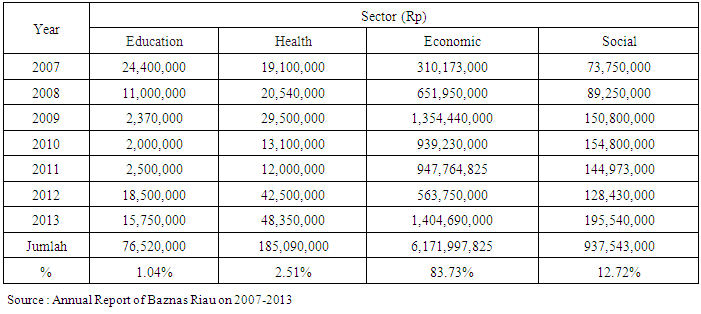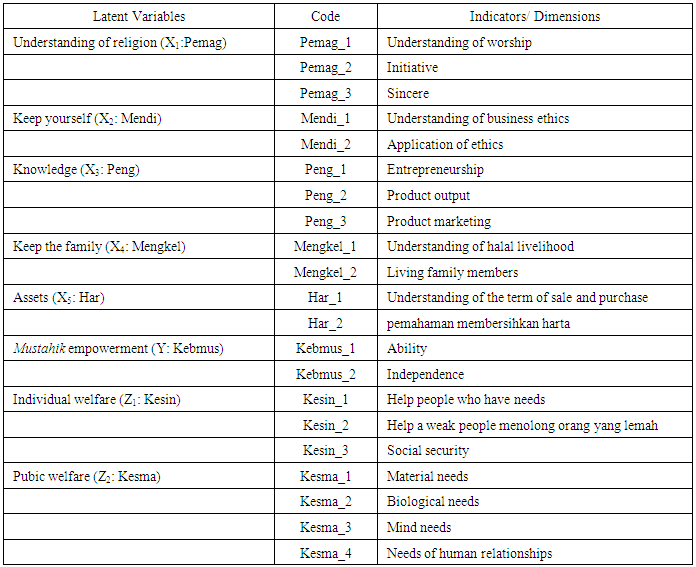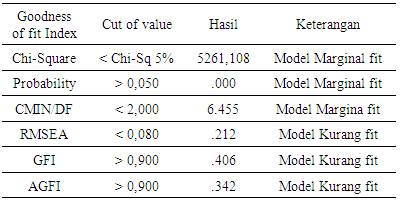-
Paper Information
- Previous Paper
- Paper Submission
-
Journal Information
- About This Journal
- Editorial Board
- Current Issue
- Archive
- Author Guidelines
- Contact Us
American Journal of Economics
p-ISSN: 2166-4951 e-ISSN: 2166-496X
2016; 6(2): 96-106
doi:10.5923/j.economics.20160602.02

The Influence of Maqashid syariah toward Mustahik’s Empowerment and Welfare (Study of Productive Zakat Recipients on Baznas Riau)
E. Armas Pailis1, Umar Burhan2, Multifiah2, Khusnul Ashar2
1Doctoral Program of Economics Science, Faculty of Economics and Business, University of Brawijaya, Indonesia
2Faculty of of Economics and Business, University of Brawijaya, Indonesia
Copyright © 2016 Scientific & Academic Publishing. All Rights Reserved.
This work is licensed under the Creative Commons Attribution International License (CC BY).
http://creativecommons.org/licenses/by/4.0/

The phenomenon of poverty in Riau Province which represents Malay tribe and is identified with Islam has been increasing from 2011 to 2012. It has convinced the author to capture the welfare in this Province through to Islamic Paradigm by using indicator maqasid al-sharia. Research aimed to examine the influence of maqasid al-sharia which includes several factors such as religion understanding, self-caring, knowledge, family-caring, wealth and empowerment of the recipients of productive zakat (mustahik) and the influence of empowerment on mustahik welfare. The number of sample is 122 respondents in Baznas Riau whom are the recipients of zakat for business capital under the frame of economic empowerment program. Analytical tools is Structural Equation Model (SEM). Research findings disclose that religion understanding, knowledge, and family-caring have influence on mustahik empowerment. Self-caring and wealth do not influence mustahik empowerment. Furthermore, mustahik empowerment influences booth individual and community welfare. Religion understanding, knowledge, and family-caring are important factors which indicate the success of community empowerment program. Self-caring and wealth are important factors but in this research, both are not influential because there is less willingness to develop the bigger business and lack of fund for business development of mustahik. The influence of maqashid syariah on the empowerment of productive zakat mustahik in Baznas Riau is 40.6 %, while the the rest is influenced by other factors. In theoretical context, other researchers must explore deeper review on welfare based on maqasid al-sharia indicators. These indicators are the alternative ones wich are more comprehensive were maqasid al-sharia indicators use material, spiritual and moral aspects in measuring human welfare.
Keywords: Maqasid al-Sharia, The Empowerment of Productive Zakat Mustahik, Mustahik Welfare
Cite this paper: E. Armas Pailis, Umar Burhan, Multifiah, Khusnul Ashar, The Influence of Maqashid syariah toward Mustahik’s Empowerment and Welfare (Study of Productive Zakat Recipients on Baznas Riau), American Journal of Economics, Vol. 6 No. 2, 2016, pp. 96-106. doi: 10.5923/j.economics.20160602.02.
Article Outline
1. Introduction
- Indonesia is a country with the largest number of Moeslim population in the world and it has a great zakat potential. Some researchs show that Indonesia’s zakat potential reach 100 million IDR as reported by Islamic Development Bank and will be more minimal when it is compared with the results of Baznas and FEM IPB in 2011 which states the potential zakat in Indonesia has reached 217 million IDR. (IMZ, 2011). Zakat becomes a potential resources for moeslim community in term of funds and asset management and it can be distributed to non-Moeslim community, especially in Indonesia. Zakat fund management model is worked by the government and society. This is done through a process of management by amil zakat, In which amil zakat gather zakat from zakat donor (muzakki) and give to receivers (mustahik). Empowerment is meant through empowerment program which is run by zakat manager (amil), mustahik could receive an assist in a form of capital for venture or investment. In purpose, it will efficiently and effectively useful for mustahik whom receive the assist and in other occasion give in return as a muzakki. According to Sabiq, (2008), zakat is a pillar of Islam which must be obeyed by Moeslims since the beginning of Islam in Mecca, unfortunately at that time there was no limitation for the amount of assets and part of ownership which will be used as zakat. After the second year of Hijrah, Prophet Muhammad made a clear explanation a kinds of treasures that is used as zakat followed by nishab and each percentage. It can be easy to understand the way of islam in term of capital (ra’sul maal) through studying and understanding zakat. Save property and freeze without invested or managed is a wrong action. The correct action is to empower, invest and manage assets well. Zakat can be a system that encourage the investment climate, the assets will reduce continuously by spending part of their zakat if those assets are not invested (Ghozali, Abdul Malik, 2009).Zakat is a capable system to make capital always rotating and moving, as a social control to fulfill poor people or poeple who need capital for venture. It is an evidence that zakat is not only used in consumptive but also can be used as capital for the poor who need capital for venture. The potential source of fund for society empowerment from Zakat funds. Data in 2013 show collection and distribution have been increasing 3,026,860,103 or 24.60%. The significant amount of the distribution is happened in 2013 with the increase in the amount of Rp. 1.66449 billion or 120.99%.Paradoxical phenomenon occurs when the trend of the collection is rising, but trend of the distribution is downward or vice versa. This phenomenon occurred in 2011 and 2012. Where in 2011 the trend on the amount of accumulation was downward, around 1.826.070.545 IDR or 1.63%, while in the distribution side occured rising trend around 1.265.923.000 IDR or 13.67%. Then the reverse phenomenon occurred in 2012 in which the accumulation of an increase of 2.429209 billion IDR or 33.03%, while in the distribution side decreased by 753.18 million IDR or 40.50%.In the development of zakat distribution in Riau Baznas of the 2007-2013, the allocation of distribution based on education, health, economic and social in which the first major allocation distribution to economic sector totaled 6.171.997.825 IDR or percentage of 83.73% in the form of capital assist either productive enterprises produce goods or services. The second largest allocation from social sector, around 937.543.000 IDR or 12.72% in the form of aid programs konsumstif, disasters and other purposes that do not include in a certain category. It can be seen clearly in table below.The empowerment of Public Finance as a welfare system in Indonesia is the role of that institution in the future which should explore creative mode in mobilizing, organinizing and facilitating in order to enhance public accountability and encourage the birth initiatives of the welfare community. The framework needs a welfare system for Indonesian in which consist of Islamic Public Finance Institution that has national character and transparent and accountable. (Yananti, 2008).According Maheran (2014), 5 elements of human needs based on maqashid sharia very strongly affect for effectiveness of zakat distribution. It concludes all human needs in perspective maqasid al-Sharia is a religion, knowledge, physical-self, family and wealth of positive influence on the effectiveness of the distribution of zakat. The Conceptual welfare with 5 indicators based on maqashid sharia are religious understanding, self defence, knowledge, family defence and property is a prerequisite of success zakat as Islamic law that elevating the welfare of a person from poverty to a more prosperous life. Empowerment through zakat programs and factual problems in the field, especially in the province of Riau, on perspective of the researchers is assumed as research gap very important and urgent to look for a solution in a further study.Based on the poverty phenomenon in Riau province with the increasing number of poverty during the period of 2011 - 2012 finally prompt researchers to capture the Islamic economic prosperity by using maqashid sharia as an indicator in order to Riau Province as Melayu region is identically with Islam. How far economic empowerment programs through Baznas Riau able to empowering in maqashid sharia context. Researchers decide on economic empowerment programs through zakat fund in National Zakat Institution (Baznas Riau) as an object of study and recieveras the unit of analysis with the focus of the research on two main issues, there are : 1) Analysing the factors of maqashid sharia (religious understanding, keeping away , knowledge, keep your family and treasure) that affect empowerment of the productive recipients; and 2) Analysing the Influence of empowerment of zakat productive recipient to the welfare.
|
2. Research Methods
- Research activities with the target are individual poor households as a productive recipients that distributed by National Amil Zakat Agency of Riau Province (Baznas Riau). The population of this research are mustahik poor households that receive productive zakat from Riau Baznas in the research location. If an individual Muslim mustahik zakat productive is the head of the family or a representative household / family, then approached the total population of poor households in the location chosen productive recipients totaling 612 people. The samples will be selected from the population mustahik productive recipients and then determined by proportional random sampling to the number of samples (n) and it was taken with a size of 122 or 20% of the entire population (Arikunto, 2006). The quantitative data collection through a survey was conducted from March to April 2014.This research uses Structural Equation Modeling analysis tools or SEM. SEM can be described as an analytical that combines of approach factor analysis (factor analysis), structural model (structural model), and a path analysis (path analysis). In Addition, SEM can be done use three kinds of activities simultaneously, that are checking the validity and reliability of the instrument (confirmatory factor analysis), analysing the relationship between variables (path analysis) and a suitable model for prediction (analysis of structural model). (Sugiyono, 2013). The analysis of the relation and influence in this study is using the technique of path analysis. Path analysis is used to analyze the relationships pattern between variables in order to detect the direct and indirect effects of a set of independent variables (exogenous) on the dependent variable (endogenous). This techniques analysis will be used to test the amount of the contribution shown by the path coefficient for each path diagram from a causal influence on the variables X1, X2, X3, X4 and X5 on the Y as well as the effect of Y to Z, correlation and regression analysis which is the basic for the calculation of structures equation model (SEM).
|
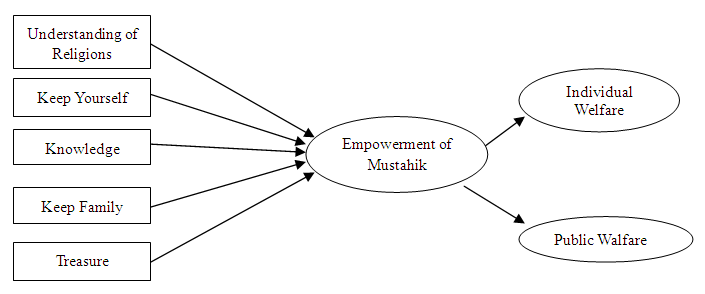 | Figure 1. SEM Model Ilustration |
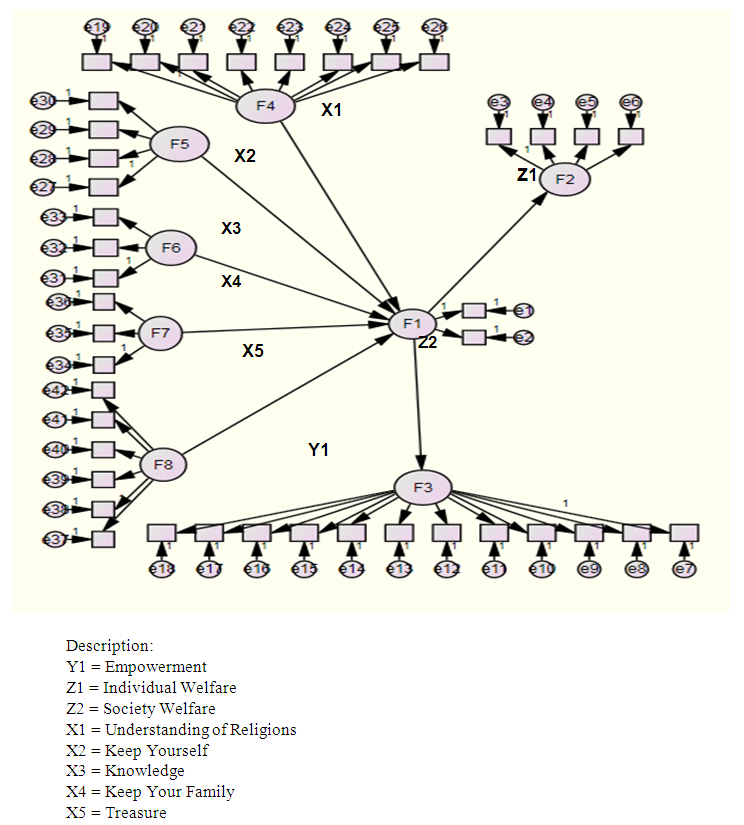 | Figure 2. SEM Analysis Model |
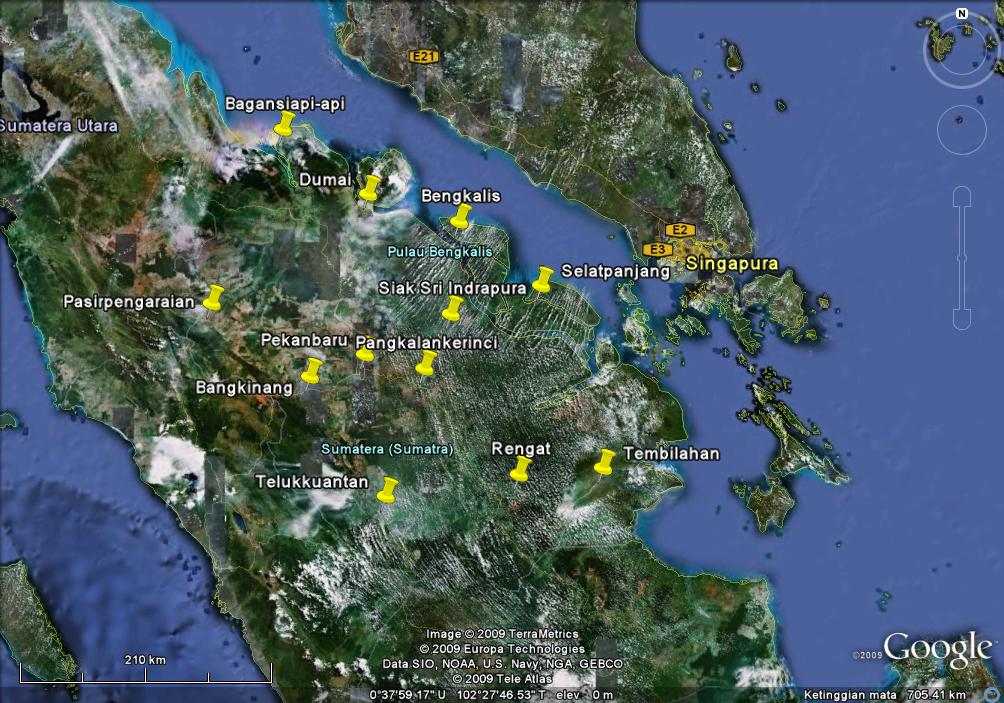 | Figure 3. Research Location Map |
3. Empirical Result
3.1. Data Analysis
- Factors that affect individual and society welfare through empowerment of mustahik with the role of zakat can be known with a structural equation model (structural equation model / SEM). Base of this model uses the theory of the impact of zakat according to Yusuf Qardawi as the basis and theory of empowerment by Edi Suharto uses the role of zakat as the purpose zakat sharia, which if we want to know the purpose of the Sharia / Islamic law (fiqh zakat) then must use the science of Ushul Fiqh based on theory maqashid Sharia (religious understanding, keep yourself, knowledge, keep your family and treasure). According to previous studies been shown to affect welfare in reducing poverty problem.Data of survey’s result are used to test the hypothesis that has been described in Chapter 3. The Processing and SEM analysis by AMOS software version of 21. According Ghozali and Fuad (2005), the exact method used to the questionnaire through ordinal scale is maximum likelihood estimation method. The following model fit in the picture 5:17 as follows:
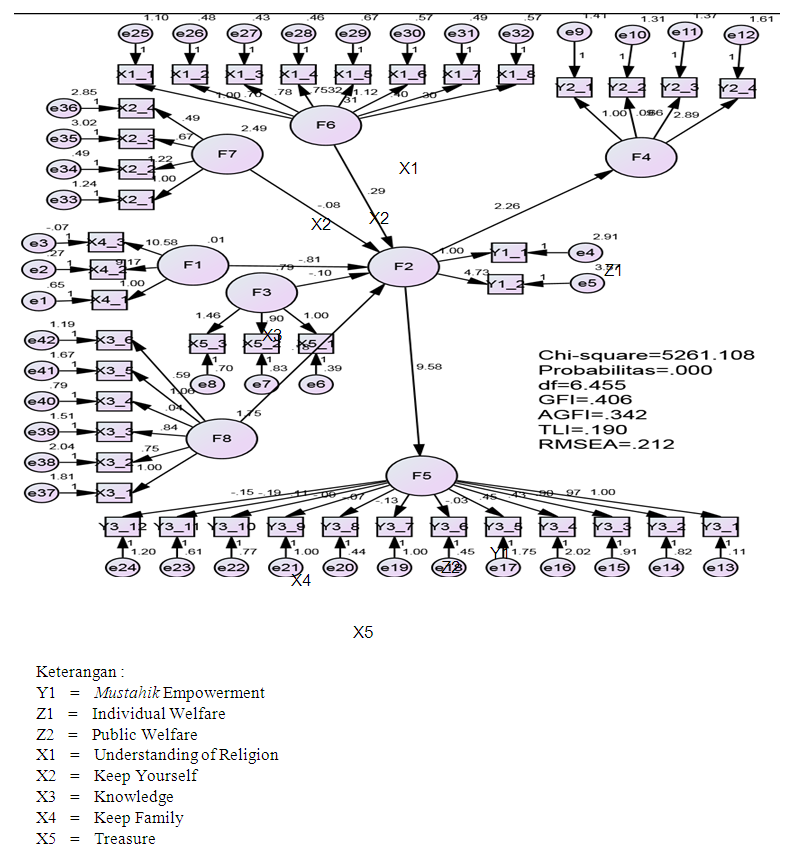 | Figure 4. Model Fit Factors of Maqasid Sharia that Influence on Individual dan Society Welfare by Empowerment of Mustahik productive zakat (Source: AMOS Processed of survey’s data on 2014) |
|
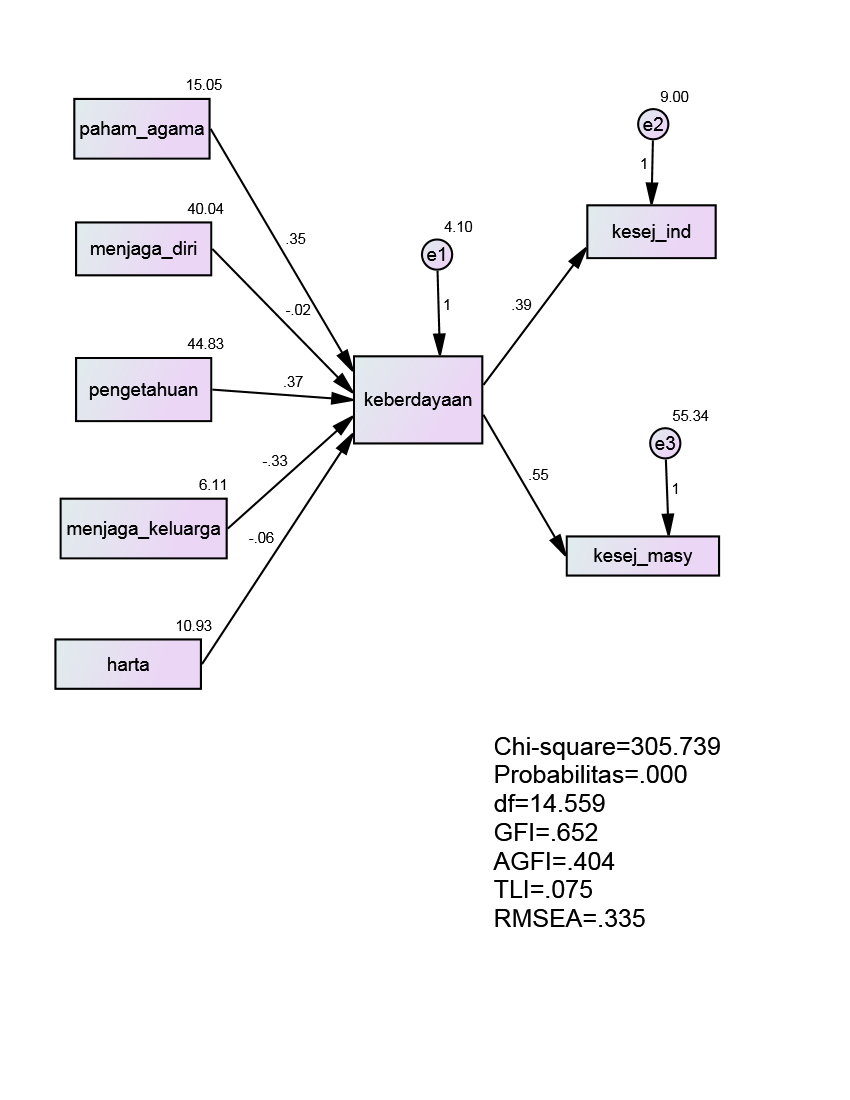 | Figure 5. SEM Model Result factors of Maqasid Sharia that Influence for Individual and society welfare through Empowerment of Mustahik Productive Zakat (Source: AMOS Processed of survey data on 2014) |
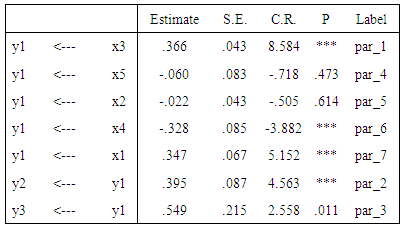 Standardized Regression Weights: (Group number 1 - Default model)
Standardized Regression Weights: (Group number 1 - Default model)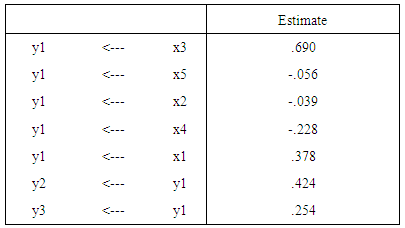 Variances: (Group number 1 - Default model)
Variances: (Group number 1 - Default model)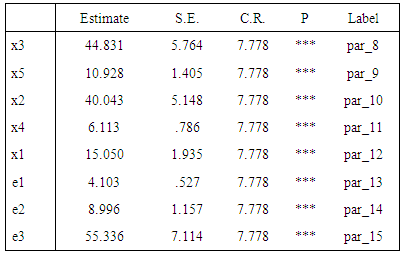 Based on standardized regression weights that there are 3 (three) factors of sharia maqashid that affect the productive empowerment of mustahik productive zakat in Baznas Riau are religious understanding factors (X1) has a value of 0.378, the knowledge factor (X3) has a value of 0.690 and a factor keeping the family has a value of -0.338 , While the two (2) factors of sharia maqashid has a small influence on the empowerment of zakat productive mustahik Baznas Riau is a factor keeping yourself has value -0039 and treasures factors have value -0.056 . Then the impact of the empowerment mustahik productive zakat Baznas Riau on the individuals welfare has a value of 0.390 and empowerment impact mustahik productive zakat Riau Baznas to the welfare of society has a value of 0.550, it’s mean that there is influence the empowerment of mustahik zakat productive Riau Baznas for the welfare of both the individual and society.
Based on standardized regression weights that there are 3 (three) factors of sharia maqashid that affect the productive empowerment of mustahik productive zakat in Baznas Riau are religious understanding factors (X1) has a value of 0.378, the knowledge factor (X3) has a value of 0.690 and a factor keeping the family has a value of -0.338 , While the two (2) factors of sharia maqashid has a small influence on the empowerment of zakat productive mustahik Baznas Riau is a factor keeping yourself has value -0039 and treasures factors have value -0.056 . Then the impact of the empowerment mustahik productive zakat Baznas Riau on the individuals welfare has a value of 0.390 and empowerment impact mustahik productive zakat Riau Baznas to the welfare of society has a value of 0.550, it’s mean that there is influence the empowerment of mustahik zakat productive Riau Baznas for the welfare of both the individual and society.3.2. The Discussion about Relationship Model of Individual and Society Welfare through Empowerment of Mustahik with Maqashid Sharia in Riau Baznas
- a. The Religion Understanding Factor’s Effect on Mustahik’s Empowerment The influence of the religion understanding factor to the mustahik’s empowerment productive zakat recipients that have a significant effect from the research findings. The understanding of relegion in the meaning of embodied worship spiritual understanding in the activitied of the intention for Allah, before the activity we must pray and fully surrender to Allah be an absolute requirement of a good Moeslim.Religion positive’s influence to the effectiveness of the zakat distribution is to be other research finding (zakaria, 2014). Religious understanding be guide and carrying Moeslim people in every activity. The realization that every move is always supervised by Allah. Meanwhile, according to multifiah (2007), religious values have a significant effect for the welfare of moeslim poor households (RTMM). The application of religious values in the family that start with the head of the family, it will be the model for his family members. It should be religious values to be the barometer attitudes and actions that can generate productivity for survival in life. b. The Influence of Keeping Yourself Factors to the Mustahik’s empowermentThe Variables of keeping themselves have not affect to the empowerment of mustahik productive zakat. It has not influential variables keeping themselves can be seen from the dimensions of understanding business ethics, where the mustahik that be a entrepreneurs on average have not been taking care of business license and or find out about licensions/regulations to establish a business, this is happen because the business carried mustahik in the micro category that never contact with the licensing which is issued by the government eventhough the level of RT.While zakaria (2014), stating the finding of physical self give a positive influence on the effectiveness of the zakat distribution. These the different findings are very important to be more attention. Keeping yourself in the sense of maintaining business continuity to be a problem which is not a domain mustahik because business regulations is not direct contact with the mustahik’s business process and the absence of requirements to be met by mustahik for business operations as well as the process of get the capital of venture. This cases will be a problem when mustahik’s business began to grow and require additional capital or place of business permit, this matter will be an obstacle for mustahik’s business continuity. c. The Influence of Knowledge Factors to the Mustahik’s EmpowermentKnowledge through training and associating of mustahik has been successfully empowered mustahik (noerwenda, 2013). The Influence from the effectiveness of training cake house programs to improve the welfare of mustahik be affected by the precision used the elements in train, achievement of goals variable and target of the training (pambudi, 2010). Training can improve the knowledge for someone, the application of learning methods is applied in the training easier for someone to improve their knowledge because it can be applied immediately after training.The influence of education (scholarships) for welfare of Moeslim poor households simultaneously with another variables that influence positively (multifiah, 2007). In the theory of human capital, the application of investment of human resources can be made in education and training, migration and the improvement of nutrition and health (simanjuntak, 1985).The research findings by 67% respondents of Malays ethnic, knowledge in terms of entrepreneurial spirit that influence for empowerment is the evidence of ethnic Malays could be a merchant/entrepreneur because the type of this work does not become the primary choice, the primary work for Malyas ethnic is be a farmers of commodity plantation crops such as rubber, coconut and palm oil, and fishermen in coastal shorelines and watersheds major rivers in the province of Riau like a Siak river, Kampar River, Rokan and Indragiri River. The shift of fields for the type of work required to have particular knowledge of mental trade, trading techniques to the calculation of profit is the goal of a merchant. The Malays do not have a trading culture that has been owned in generations of the Minang tribe that be a competitor in trade affairs in the Riau province. d. The Influence of Keeping Families Factor to the Empowerment of Mustahik Keeping the family variable has a significant influence to the effectiveness of zakat distribution (zakaria, 2014). The importance of maintaining a family from bad deeds and honor of the family. Bad behavior from the family can be sourced from giving anathema’s sustenance for the family’s members. A source of sustenance from deceptive, reduce weight, and other bad deeds known to affect the lives of families. Blessing treasures acquired be more important than the quantity of assets acquired (Hafidhuddin, 2012). Blessing can be measured from the savings that we can do and the increase in the assets that we have. Family that is consist of wife and children are the human capital if given the empowerment, all of them will generate productivity that can help the family’s income. The duty from head of the family is to fullfill the family members needs from the aspects of the physical form of food, clothing and housing and spiritual aspects such as teaching religion, giving a kosher living source and motivate family members to be serious in their respective roles to get better life in the future and decent compared to the present life. e. The Influence of Treasure Factor for Mustahik’s Empowerment The treasure factors have not significant effect on mustahik’s empowerment. This caused from dimensional understanding of the terms of sale and purchase according to sharia transactions is not well understood by mustahik and also understanding to clean up the assets with infaq in shortage states not become a habit that is actually still advisable of religion. There is an effect of 10% of venture capital assistance in increasing revenue mustahik and the remaining 90% are influenced by other income. It indicates that the productive zakat fund becomes mustahik capital of venture is not only source of mustahik’s income. (Sartika, M, 2010).The Productive zakat fund assistance for mustahik gives significant effect on capital changes of mustahik (Sucipto 2009, Aji, 2011, Zaelani, 2013). While in other research, treasure variables significantly influence to the effectiveness of zakat distribution (zakaria, 2014). The Capital simultaneously gives significant influence for poor households welfare (RTMM) (multifiah, 2007)Meanwhile Hasibuan and Dumairy (2013) based on OLS method, f test was conducted and show that the variable capital, the role of managers and mentoring are not significant effect on empowerment.The small capital assistance that has been given is not able to remove mustahik from poverty, it is complained by mustahik. Amil agency reasoned that the mustahik’s queuing to get capital support from the empowerment programs is to much, so it must be adjusted with capabilities and low awareness muzaki give zakat through amil agency that impact on small accumulation of zakat and also not accordance with the existing potential. f. The Influence of Mustahik’s Empowerment to Individual Welfare Mustahik’s empowerment of productive zakat significant impact on individual welfare, the dimensions of helping people who need, helping people in distress and happy to feed others. One of mark a prosperous people are able and capable to sharing or helping others especially in difficult conditions.According to Ahmed (2013), while the macro-economic policy has an important role in reducing poverty, poverty can not be eliminated without uses of zakat in an effective way. There are certain conditions in which zakat make an impact to reduce poverty with the first requisite, zakat should be equipped with strong macro-economic policies that promote growth and distribute income to reduce poverty second, zakat is collected and distributed, the impact on poverty will be significant when a larger percentage from zakat used to be productive sector.The impact of zakat for recipient must be freed from the necessity, Islam wants human beings to live in good condition, have fun in life freely, feel happy because his needs are met, the fulfillment of material needs as one of life's important to be realize a happiness life. There are four signs that human happiness, first is solehah’s wife, spacious home, a good neighbor and a good vehicle. Ideally, the government picks up and distribute zakat in Indonesia. Amil Institution (Baznas) become the central institution for managing of zakat, the agency making mustahik feel great heart, his head upright and perfect glory because he took the rights that have been clear to him (Qaradawi, 2012). g. The Influence of Mustahik’s Empowerment to Society Welfare There are a significant impact from mustahik’s empowerment on society welfare, the dimensions of the material needs, biological, mind and human relationships. Target of zakat from the social side is no doubt with regard mustahik of zakat as a broader social responsibility, it is wider than social security or insurance that known in the West only in the narrow scope such as job security, helping groups of people whom are weak or poor. While Islam introduced zakat as a social responsibility broader include material and spiritual aspects of life such as morals assurance, education, politics, defense guarantees, economic security, guarantees of humanitarian, cultural and last guarantee of social security.The Impact of zakat from economic side by prohibiting amass the wealth, so the wealth will rotate, be invested, the real sector working, economic wheels moving, and increased of productivity. Zakat as a whip that could bring the treasure to make a business, give to charity and developed so as not devour time.Upholding community spirit to uphold a noble character followed and implemented by Muslims as well as maintaining the spirit and values with personality. Islam uphold three basic principles, there are first, complete independence for every individual, second, uplifting the human person and human values in handing something useful for society, both mental and material or reject something bad that feared will happen and the third, maintaining the faith and education to purify basic human nature (Qardhawi, 2012).
4. Conclusions
- This research describes about maqashid sharia as an indicator of the welfare through empowerment of mustahik productive zakat in Riau Baznas. Therefore, the results of this research can be given suggestions as follows:1. Regard to the limitations of this research, it is suggested in advanced study, researhcer can use the entire of Amil Agency to be a respondends and open to all mustahik, not limited to productive zakat.2. Given the Amil Agency (Baznas Riau) be the central of management of zakat in Riau province on economic empowerment program with more emphasis on understanding aspects of religion, aspects of knowledge and the family aspect that proved influential on mustahik’s empowerment and welfare.3. Baznas Riau in the selection process of productive recipients can filter mustahik whom have an entrepreneurial mindset and really need to capital of venture, then can following the training to improve the ability of manage the business and performed assistance to have the ability to survive and self-reliance in developing a business. Lack the capital of venture that disbursed and no one follow-up of program to obtain additional capital as well as a lack of business understanding, especially in terms of maintaining continuity of the business in the future that must be a serious concern to the ultimate from mustahik become a muzakki can be realized.4. Empowerment of poor houshold society through productive zakat for individual welfare need to be improved, especially for social security from government institutions that directly impacted on individual of poor households.
 Abstract
Abstract Reference
Reference Full-Text PDF
Full-Text PDF Full-text HTML
Full-text HTML